Inside America’s mortality misinformation crisis.
Canada’s Death Option

Using euthanasia to backstop your spotty universal health care system.
“Dying in a hospital is not what’s natural. That’s not what’s soft. In these kind of moments, you need softness.”
So opens Canadian fashion retailer La Maison Simons’ lavishly produced viral video promoting “medical assistance in dying” (MAID). The voice is that of Jennyfer Hatch, a 37-year-old woman suffering from Ehlers-Danlos syndrome, whom Canada’s healthcare system put to death in October.
The fashion retailer orchestrated quite a sendoff for Jennyfer. The video’s opening image of a hospital room being swept away by the sea is followed by lovely scenes of women singing, feasting, hugging, and saying their goodbyes in chic, vaguely paganized natural settings. This improvised ritual is the “softness” Hatch recommends in place of the hospital or hospice. Whether the lethal injection itself should be deemed “soft,” neither Hatch nor Simons has the courage to say.
It is easy to sympathize with Hatch’s desire to end her painful life on her own terms. And her bespoke ritual attempts to recapture elements of what used to be normative before atomized modernity—dying well-loved in the embrace one’s family and community. Anyone’s sincere effort to grapple with suffering and achieve meaning deserves sympathy. But what Simons sells as autonomy’s final victory over debilitating illness was really a concession to bureaucratic apathy. The National Post reports, “Hatch’s case fits into an ever-expanding constellation of Canadians who want to live, but applied for medically assisted death out of desperation after failed attempts to seek appropriate care.” British Columbia’s healthcare system would not even provide her with palliative care once her disease became terminal. It promptly approved her request for MAID, however.
Three weeks before Simons released its slick propaganda piece, the Canadian House of Commons entertained the question of whether it should be permissible to euthanize infants up to the age of one. On October 7, Dr. Louis Roy testified on behalf of the Quebec College of Physicians that death by lethal injection is suitable for children “with severe deformations and…very grave and severe syndromes…whose life expectancy and level of suffering are such that it would make sense to ensure that they do not suffer.”
The College’s position represents a further radicalization of Canada’s MAID movement, whose most recent victory ensures that, beginning next spring, even depression will qualify one for euthanasia. Dr. Roy’s comments echoed the College’s previous suggestion that Canada should adopt the Netherlands’ Groningen Protocol, which established legal guidelines for medical infanticide. The Protocol emphasizes the presence of “hopeless and unbearable suffering” alongside the informed consent of the parents. The child, of course, is as incapable of giving consent as she is of confirming her hopelessness or her ability to endure suffering, so these must be determined by others.
The sophistication of the human brain notwithstanding, we simply cannot know the subjective experiences of other people. We can imagine our way into experiences not our own, but the irreducibility of subjective consciousness ensures that our imaginings are at best educated guesswork. At worst, however, our assessment of another’s suffering is really an expression of our own: I cannot tolerate watching you suffer, therefore your suffering must be intolerable. It is the broken logic of psychological projection.
The idea of parents “consenting” to their child’s killing is no less incoherent. Can a mother and father “consent” to selling their daughter as a sex slave? Whatever moral meaning the term possesses in the case of slavery, it possesses even less with respect to euthanasia. We may permit or will something to be done to a person in our care, and we may do so in accordance with that person’s expressed wishes, but we cannot perform or determine an act of subjective consciousness for (as) anyone but ourselves.
Alex Schadenberg, executive director of the Euthanasia Prevention Coalition, argues against Roy that there is no justification for infanticide even granting its proponents’ premises, because these children are already in the process of dying. “Why would you then have to give the child a lethal dose? If the child is not going to survive, the child can be kept comfortable and die naturally. There’s no reason for us to kill the child.”
This is all obvious to the morally sane. Alas, moral sanity is steadily vanishing from western medical communities, and from large swaths of the societies they serve. Given Canada’s recent violations of its citizens’ bodily autonomy during the pandemic, and given that virtue signaling to the culture of death apparently helps sell designer clothes, it is a safe bet that the country will soon go the way of Groningen.
Some U.S. states already tolerate infanticide of healthy babies. Maryland recently decriminalized the killing of infants up to 28 days old, when the killing is accomplished by “inaction.” Last fall, Montana rejected a ballot measure that would have required medical care be provided to infants “born alive” during botched abortion procedures. All but two Democrats in the House of Representatives just voted against a similar national measure. Groningen-style proposals for full-blown medical infanticide well beyond the perinatal period are just around the corner.
In the space of two decades, proponents of euthanasia have moved beyond the sympathetic case for “death with dignity” to advocate for expansive death-on-demand. How did this happen? What made that slope so slippery?
The logic used to justify cases like Hatch’s possesses no limiting principle. It applies just as easily to the termination of infants, the disabled, the mentally ill, and the homeless. In the end, because the “patient” must seek approval for MAID, it is the system’s consent that is determinative. The patient’s consent is an illusion; in the case of infanticide, it’s even less substantial. Because the system arrogates to itself the power to declare as objective what in truth is irreducibly subjective, “murder” ceases to be a morally coherent concept. As a matter of logical necessity, if one accepts MAID—especially for infants—one should feel free to impose MAID on anyone.
To take this argument to its own absurd conclusion, one may justifiably impose MAID upon its most impassioned advocates, like Dr. Roy. His support for infanticide, after all, might be taken as unambiguous proof that he is experiencing “hopeless and unbearable suffering.” To end his torment would, by his own account, be a mercy.
Even if the supporter of infanticide contends that his suffering is neither hopeless nor unbearable, that his life is indeed worth living, we aren’t obliged to pay him any mind. Even if he is faithfully reporting his subjective conscious experience—which is doubtful—it is our subjectivity that counts. That, of course, is precisely what he affirms in the case of suffering infants.
To take his logic to its fullest implications, we might consider blanketly deputizing any willing citizen to administer the lethal dose, at any time and in any place. Why allow such trivialities as medical licensing to stand in the way of one’s right to die? For that matter, why limit the means of one’s dying with “dignity” to a hypodermic cocktail of midazolam, propofol, and rocuronium? After all, our great nation possesses a surfeit of fentanyl, not to mention handguns and rope.
MAID advocates, of course, refuse to acknowledge the nihilism inherent in their reasoning, and eagerly mistake reductio ad absurdum arguments like mine for the slippery slope fallacy. But this doesn’t mean they are unpersuadable.
Canada’s College of Surgeons and Physicians has just proposed prohibiting doctors from recording MAID as the cause of death on the decedent’s death certificate. It seems that Canada’s MAID advocates are embarrassed by their body count—30,000 and climbing since euthanasia was legalized nation-wide in 2016.
One hopes that people still capable of feeling shame might yet remain capable of feeling remorse.
The American Mind presents a range of perspectives. Views are writers’ own and do not necessarily represent those of The Claremont Institute.
The American Mind is a publication of the Claremont Institute, a non-profit 501(c)(3) organization, dedicated to restoring the principles of the American Founding to their rightful, preeminent authority in our national life. Interested in supporting our work? Gifts to the Claremont Institute are tax-deductible.
The truckers’ occupation of Ottawa has revealed the fecklessness of the Regime.
While we are finally starting to win the fight for our children’s minds, we are losing the battle for control of their bodies.



